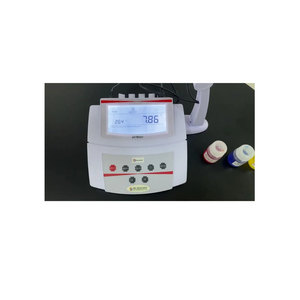
Features pH meter
Intelligent pH meter Measurement: Auto-Buffer Recognition and Electrode Slope Monitoring Modern pH meters incorporate advanced features like auto-buffer recognition and electrode slope monitoring to ensure accurate and reliable measurements. These features streamline the calibration process, provide valuable insights into electrode health, and ultimately contribute to the integrity of experimental data. Let's delve into how these functionalities enhance pH measurement precision. pH meter Auto-buffer recognition simplifies the calibration process by automatically identifying the pH value of the calibration solution. This eliminates the need for manual selection of buffer values, reducing the risk of user error and speeding up the calibration procedure. The meter is pre-programmed to recognize commonly used buffer solutions, such as pH 4.01, 7.00, and 10.01. During calibration, the meter measures the voltage generated by the electrode in the buffer solution and compares it to the expected voltage for that specific pH value. However, if a discrepancy arises between the measured voltage and the expected voltage for the selected buffer, the meter triggers an error indicator. This signals a potential issue with the calibration solution, the electrode, or the meter itself. Several factors can contribute to this error, including:- Contaminated Buffer Solution pH meter: Impurities in the buffer solution can alter its pH value, leading to a mismatch during calibration. Using fresh, high-quality buffer solutions is crucial for accurate calibration.
- Faulty Electrode: A degraded or damaged electrode may not respond accurately to changes in pH, resulting in an incorrect voltage reading. Regular inspection and proper maintenance of the electrode are essential.
- Meter Malfunction: While less common, a malfunction within the pH meter itself can also lead to calibration errors. Regular calibration and maintenance checks can help identify potential meter issues.
- 95-105%: Optimal electrode performance.
- 90-95% or 105-110%: The electrode is still usable but may require more frequent calibration.
- Below 90% or above 110%: The electrode is likely degraded and should be replaced to ensure accurate measurements.
Temperature Compensation:
The meter provides temperature compensation mode for optimum accuracy under variable temperature conditions manually.
Housing:
The integrated plastic housing & keypad is sealed to protect against accidental spills. The holder arm is rapidly switched to both sides & swivels and articulates for convenient use and positioning.
Automatic Calibration:
The meter is capable of calibrating up to 2 points using USA or NIST pH standard buffer. Press the CAL key to enter calibration mode and immerse pH sensor into indicated calibration solutions. Press ENTER key and meter is automatically calibrated.
| Feature | Specification |
| pH Range | 0.00~14.00pH |
| pH Accuracy | ±0.05pH |
| mV Range | -1999~1999mV |
| mV Accuracy | ±10mV |
| Temperature Compensation | 0~100°C, Manual |
| Calibration Points | 2 points |
| Calibration Solutions | USA (pH4.01, 7.00, 10.01) or NIST (pH4.01, 6.86, 9.18) |
| Power Requirements | DC9V, using AC adapters, 220VAC/50Hz |
| Dimensions | 210(L)×205(W)×65(H)mm |
| Weight | 1 .7kg |








